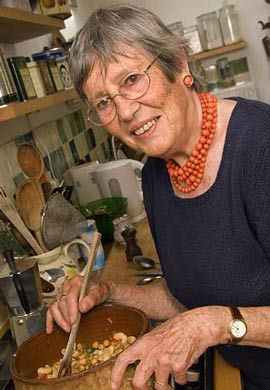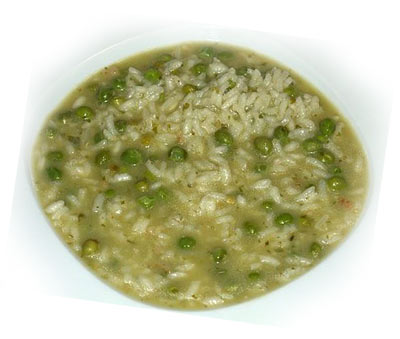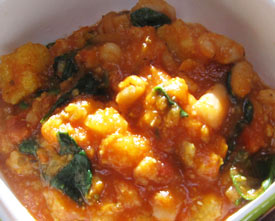|
|
Michelle's 
Anna del Conte's Risi e Bisi and Gluten, wheat, egg, soya and nut free; can be dairy free Italian food guru, Anna del Conte, gets very frustrated by You can buy all of Anna's books here on Amazon
Risi e Bisi Anna has given the original recipe first which is gluten-free but not dairy free, and then an alternative dairy-free version. This dish is a good example of the excellence of Venetian Home cooking. Homely and even humble it may be, but it is one of the very few dishes that can boast patronage of the Doges. Risi e Bisi was served to the Doge on St Mark’s Day, the 25th April, when the first peas arrive at the Rialto Market. The Doges had first claim on the primizie – early crops – from the islands on the lagoon, and particurlarly the peas from the island of San t'Erasmo. As Dino Boscorato, owner of the well known Trattoria Dall’ Amelia, put it, the Doge had the ‘ius primi bisi’ – the right not of the first night, but of the first peas! When I went to his restaurant in Mestre not long ago I had a remarkable meal as well as an interesting talk. He was very dismissive of some new versions of risi e bisi which add cream at the end of the cooking or where, instead of the stock being made with pea pods to accentuate its sweet flavour, it is made with meat, chicken or vegetable stock.  The Recipe The Recipe
This recipe derives from the risi e bisi I ate at Dall’s Amelia. It is like a very thick soup – half way between a risotto and a soup – and should be eaten with a spoon. The Venetian peas are just like small petits pois, not easy to find in this country, but nowadays you can buy sugar snap peas, which are often large but can still be eaten whole, pod and all. I find them suitable for this recipe because the pods, which go in the soup, are sweet and fleshy, and not too stringy. If the sugar snap peas are very fresh and small, you can liquidize and process the cooked pods and add the purée directly to the stock. If they are older and bigger, I advise you first to process the pods and then push them through a food mill to rid them of strings. An old version recipe adds few fennel seeds, a very imaginative and successful addition. SERVES 4 900g/2lb young fresh petits pois or sugar snap peas. If you cannot find sugar snaps, use the smallest peas you can find Top and tail and pod the peas keeping the pods and peas separate. Discard any blemished pods and wash the others. Put them in a pan and add 1.5 litres/2 ½ pts of water and 2 tablespoons of salt. Boil until the pods are very tender. Drain, reserving the liquid and process the pods. If stringy, and I find that they are usually are, work them through the small hole disc of a food mill or through a metal sieve. Measure 1 litre/1 ¾ pts of the liquid and add to the puree. Put the mixture in a saucepan and bring slowly to the boil. Add the rice and stir to coat the grains in the butter and oil. Pour over the simmering pod stock containing the pod puree. Mix well and bring to the boil. Now add the fennel seeds and some freshly ground pepper and boil, covered until the rice is cooked – about 15-20 minutes depending on the quality of the rice. Turn off the heat and mix in the Parmesan and the remaining parsley. Ladle the soup into individual soup bowls and serve immediately. Alternatively transfer the soup into a soup tureen and bring the tureen to the table, this being the way is done in Venetian homes. Dairy-free version Use 4 tbps of olive oil to cook the instead of the onion instead of the butter and oil. Instead of adding the Parmesan at the end, season with plenty of pepper and the grated nutmeg and mix in the remaining parsley and the mint. N.B. If you are lactose as opposed to dairy intolerant (or allergic), you should be able to eat the Parmesan although not the butter. The lactose in very well matured cheeses, such as Parmesan, has been almost entirely broken down so should not cause a problem. See Cheese on a low-lactose diet by dietitians Anita MacDonald and Pat Portnoi.
Polenta and Cannellini Beans - Impastoiata
Serves 5 to 6. 2 tbsp olive oil First make the sauce. Put in the oil, onion, garlic sage, rosemary, 1 teaspoon of salt and plenty of pepper in a saucepan and cook for 10 minutes over a low heat. Add the tomatoes and cook until the sauce has thickened and the oil come to the surface – about 20 to 25 minutes.
|

 The name of this dish is descriptive. Impastare means to knead and impstoiata is a mixture similar to dough. It is one of the
more esoteric polenta dishes since the dressing of stewed beans
is added to the polenta while it is still cooking for a final cooking all together. It is a lovely earthy dish and very healthy too. I derived this recipe from one of my favourite books, Un Scol di Cucina Corsi (A Century of Umbrian Cooking) by Guglielma Corsi.
In the original recipe the polenta is made with water but I find stock gives more flavour.
The name of this dish is descriptive. Impastare means to knead and impstoiata is a mixture similar to dough. It is one of the
more esoteric polenta dishes since the dressing of stewed beans
is added to the polenta while it is still cooking for a final cooking all together. It is a lovely earthy dish and very healthy too. I derived this recipe from one of my favourite books, Un Scol di Cucina Corsi (A Century of Umbrian Cooking) by Guglielma Corsi.
In the original recipe the polenta is made with water but I find stock gives more flavour.





